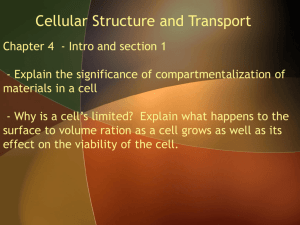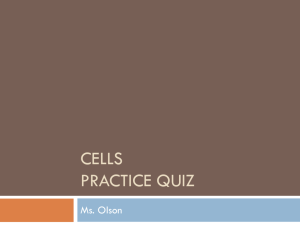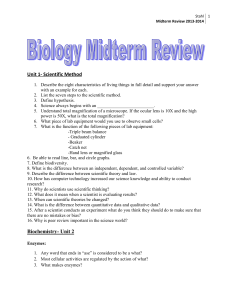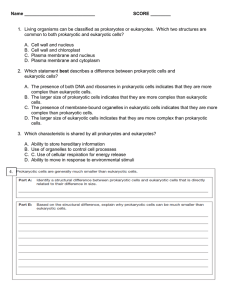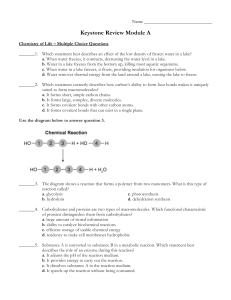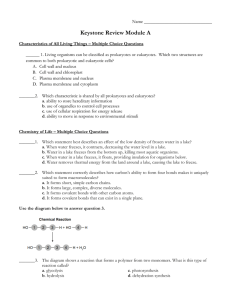Midterm 2013 – Free Response Section AP Biology For your
advertisement
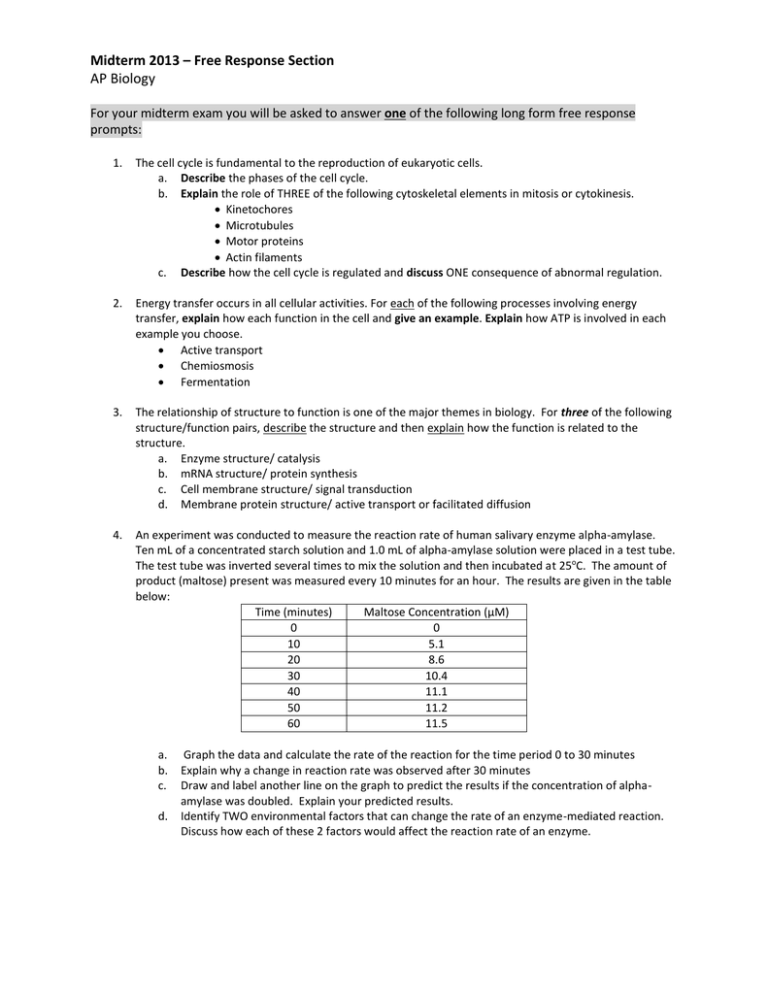
Midterm 2013 – Free Response Section AP Biology For your midterm exam you will be asked to answer one of the following long form free response prompts: 1. The cell cycle is fundamental to the reproduction of eukaryotic cells. a. Describe the phases of the cell cycle. b. Explain the role of THREE of the following cytoskeletal elements in mitosis or cytokinesis. Kinetochores Microtubules Motor proteins Actin filaments c. Describe how the cell cycle is regulated and discuss ONE consequence of abnormal regulation. 2. Energy transfer occurs in all cellular activities. For each of the following processes involving energy transfer, explain how each function in the cell and give an example. Explain how ATP is involved in each example you choose. Active transport Chemiosmosis Fermentation 3. The relationship of structure to function is one of the major themes in biology. For three of the following structure/function pairs, describe the structure and then explain how the function is related to the structure. a. Enzyme structure/ catalysis b. mRNA structure/ protein synthesis c. Cell membrane structure/ signal transduction d. Membrane protein structure/ active transport or facilitated diffusion 4. An experiment was conducted to measure the reaction rate of human salivary enzyme alpha-amylase. Ten mL of a concentrated starch solution and 1.0 mL of alpha-amylase solution were placed in a test tube. The test tube was inverted several times to mix the solution and then incubated at 25oC. The amount of product (maltose) present was measured every 10 minutes for an hour. The results are given in the table below: Time (minutes) Maltose Concentration (µM) 0 0 10 5.1 20 8.6 30 10.4 40 11.1 50 11.2 60 11.5 a. b. c. d. Graph the data and calculate the rate of the reaction for the time period 0 to 30 minutes Explain why a change in reaction rate was observed after 30 minutes Draw and label another line on the graph to predict the results if the concentration of alphaamylase was doubled. Explain your predicted results. Identify TWO environmental factors that can change the rate of an enzyme-mediated reaction. Discuss how each of these 2 factors would affect the reaction rate of an enzyme. For your midterm exam you will be asked to answer two of the following short form free response prompts: 1. 2 = ∑(o-e)2/e 2. Homeostatic maintenance of optimal blood glucose levels has been intensively studied in vertebrate organisms. One of the pancreatic hormones, insulin, regulates blood glucose levels. For insulin, identify ONE target cell and discuss the mechanism by which it can alter activity in that target cell. Include in your discussion a description of reception, cellular transduction, and response. 3. Membranes are essential components of all cells. Identify THREE macromolecules that are components of the plasma membrane of eukaryotic cells and describe the structure and function of each. 4. A major distinction between prokaryotic and eukaryotic cells is the presence of membrane-bound organelles. Prokaryotic and eukaryotic cells have some non-membrane bound organelles in common. Describe the function of TWO of the following below and discuss how each is differs in prokaryotes and eukaryotes. DNA Cell Walls Ribosomes 5. The rate of photosynthesis may vary with changes that occur in environmental temperature, wavelength of light, and light intensity. Using a photosynthetic organism of your choice: a. Identify one independent variable from above and explain how you would change that variable. Include at least 3 treatment levels and a control group. Explain how you would measure the rate of photosynthesis in your experiment b. Describe the results you would expect. Explain why you would expect these results 6. Explain how reduction of chromosome number and rearrangement of chromosomes are accomplished by meiosis. Include in your explanation the importance of these occurrences (reduction and rearrangement) to the survival and fitness of a species.
